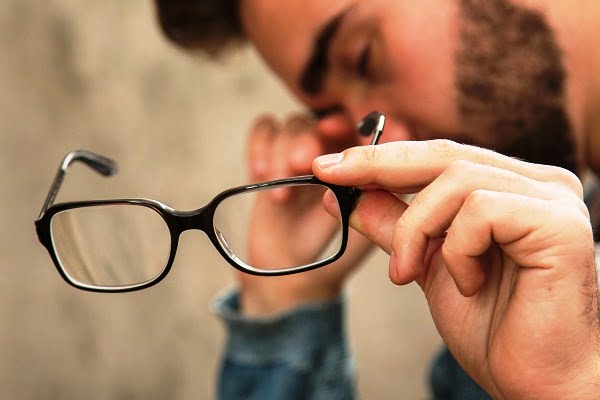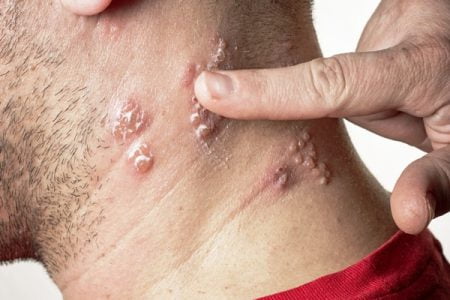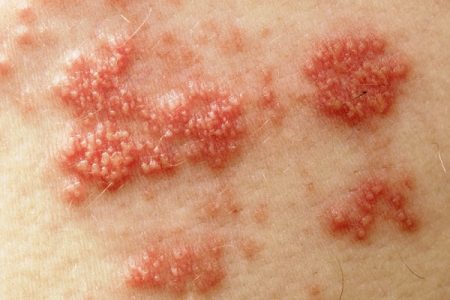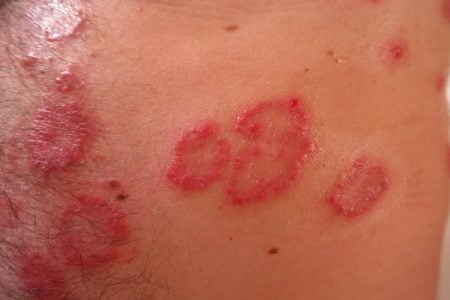
What is shingles?
Shingles is a painful skin condition that is caused by the varicella zoster virus. It is the same virus that causes Chickenpox is. Shingles is also known as herpes zoster or simply as zoster.
Shingles is a viral disease that can exhibit many signs and symptoms. The virus can affect any part of the body but is more commonly found on torso, trunk, neck, face, ears and eyes. The disease causes rashes or blisters generally on one side of the body in a clustered pattern. This unique identifying of the disease distinguishes it from other skin diseases.
Read more about Shingles.
Shingles in the eye: Can you have shingles in your eyes?
According to available data, in about 15 to 20 percent of people suffering with shingles, the rash and blisters (that are characteristic features of shingles) appear in and around the eye. The shingles of eye is sometimes called ophthalmic herpes zoster or herpes zoster ophthalmicus.
Shingles in the eye can cause many signs and symptoms such as scarring, vision loss, and other eye problems. The symptoms of shingle in the eye can be prevented with vaccination.
Symptoms of shingles in the eye
The first sign of shingles in most people is a tingling sensation or burning pain, generally on one half side of the body. The virus commonly affects the torso, trunk, neck, face, ears and eyes. Within a few days, the patient develops rashes on the body. The rashes then convert into painful blisters in the next 2-3 days of developing the rashes.
Read about signs and symptoms of shingles.
Along with the general signs and symptoms of Shingles, if Shingles affects the eyes, the symptoms are more visible in and around the eye area.
If you have shingles of the eye, the blistering rash will appear on your eyelids, forehead, and sometimes on the nose. These blistering rashes on and around the eyes may appear at the same time or a few days or sometimes a few weeks after the skin rashes have gone away. Along with the rash on and around the eye, you may notice these signs and symptoms of shingles in the eye:
- headaches with pain in one side of the head may be an initial sign of shingles in the eye
- burning sensation in the eye
- blurry vision or reduced vision
- swelling and pain in and around the affected eye
- sensitivity to light
- swelling in the eyelid or retina or cornea
- redness in and around the eye
- watery eyes / tears in the eyes
- irritation in eyes
- pain in the eye
Sign of shingles virus spreading to the eyes
A common sign that Shingles is spreading to the eyes is the appearance of rash on the nose. The virus may then spread from the nose to the eye or nearby area. The cornea of the eye may begin to change colour and look slightly gray. This is a sign of shingles in the eye and requires immediate care to avoid further damage or complications to the eyes. If treatment is not delivered at the right time, one the disease can cause scarring of the cornea and lead to complete or partial blindness.
When to call doctor
If you observe any of the above symptoms in and around your eyes or other general symptoms of shingles, contact your doctor immediately. An early treatment can help save your eyes from many eye complications that can otherwise develop as a result of shingles in the eyes.
Cause of Herpes Zoster Opthalmicus (Shingles of the eye)
The cause of Shingles is the same virus that causes chickenpox infection. If as a child you had suffered with chickenpox, then the virus that affected you and caused you chickenpox (varicella zoster) will still be living in your body even though you have recovered from the disease.
When you fall sick and get chickenpox due to the varicella zoster virus, your attacks it to get rid of the disease causing agent in the body. But, not all the viruses in your body are completely destroyed. Some may remain inside your body. The virus resides in the nerve tissue in a dormant or non-active state and does not interfere in normal bodily functions. But with a weakened immune system (for some reason), the virus gets an opportunity to grow unchecked and cause the disease shingles. Shingles of the eye occurs when the virus affects the eye or around the eye area. Read more about causes of Shingles.
Diagnosis of shingles in the eye
Your doctor will be able to diagnose shingles by looking at the rash on your eyelids, scalp, face and the rest of the body. The eye doctor may take a sample of the fluid from the blisters for examination to test for the varicella-zoster virus.
Your eye doctor will examine:
- Cornea of the eye
- Retina of the eye
- Your lens
- Areas around the eyes
- Other symptoms on the face
One of the ways Herpes Zoster Opthalmicus (Shingles of the eye) is diagnosed is a clinical examination which is done by an eye doctor called ophthalmologist. A physician may also work along with the ophthalmologist to treat certain symptoms. A course of treatment is defined for the patient based on the evaluation by your eye doctor and the physician.
Read more about diagnosis of shingles.
Prevention of shingles in the eye
You can avoid shingles by getting the shingles vaccine. The vaccine is recommended for people age 60 and older. The U.S. Food and Drug Administration has approved a vaccine for use by people age 50 and older as well.
You should get in touch with your doctor to know when you should get vaccinated for shingles. The vaccine can cut your risk of getting shingles by more than 50%. It can also reduce your chances of getting long-term nerve damage significantly.
These are certain other preventive measurements for avoiding shingles in the eye. Most of them are centered around avoiding close contact. This is particularly important during the contagious stage of the disease, when you have blisters on the skin. If you have never had chickenpox, you still can catch the varicella- zoster virus, but you will develop chickenpox and not shingles as a result of it.
- Reducing the risk of transmission from an affected person: If you are living with a person or are yourself suffering from the disease, it is important to ensure that the person always covers the affected rashes and blistered areas to reduce the risk of transmission to others
- The affected areas should be washed and dressed with new bandages daily
- The hands should be washed thoroughly if they come in contact of an affected person or his/her bandages or other utility items that might be the source of transmission
- People who have weakened immune system such as a pregnant woman should stay away from someone suffering with shingles
- Try to avoid scratching the rash if you have shingles
Treatment of shingles in the eye
If Shingles of the eye is left untreated, it can cause major complications. The treatment must begin as soon as the patient is diagnosed with Shingles of the eye or there is a risk of the person going blind.
Common ways of treating shingles of the eye are:
- Shingles disappears gradually by itself after it has run its course. This is the same for Shingles of the eyes also. Most medicines that your doctor may prescribe are for relieving the symptoms particularly pain.
- Analgesics are commonly recommended to relieve the pain from shingles of eyes. These medicines are taken as per prescription or can be bought as over-the-counter pain relieving drugs from pharmacies.
- One of the ways to relieve the symptoms is to cool the area around your eyes by applying topical creams that have calamine in them. The use of calamine-based creams gives relief and soothing affect to the area around the eyes.
- If you have extreme headaches and pain around the eye, your doctor may prescribe stronger painkillers such as morphine.
- Antivirals are usually not used in shingles, but some physicians may prescribe them to expedite the recovery. Acyclovir and famciclovir are two antivirals commonly used by doctors, if at all they prescribe any antiviral medicine.
- For patients suffering with acute pain, steroids are given to relieve immediate pain.
How long does it take to recover from shingles in the eye?
The blisters start to burst over and heal in 1 to 3 weeks. The disease then goes away slowly by itself after its course is complete. However, the pain or irritation in the eye or around the eye usually takes more time. You may feel pain even after 3 to 5 weeks. If the virus has damaged a nerve, you may have pain, numbness, tingling or other sensations for months after the rash is healed.
Complications of shingles in the eye: Can you go blind from shingles in the eye?
The shingles rash go away after completing the course of the disease after a few weeks, but the pain can continue for many more weeks or months. In some cases, the disease is left unattended, one can go blind.
Common complications of shingles in the eye are:
- Pain due to nerve damage (postherpetic neuralgia). In most cases, the nerve pain will get better gradually after a few weeks.
- Swelling of the cornea may leave permanent scars
- Swelling of the retina
- Glaucoma – increased eye pressure
- Injury to the cornea
- Vision loss
- Complete blindness






